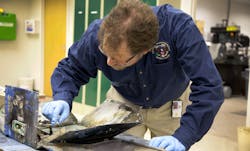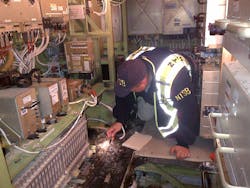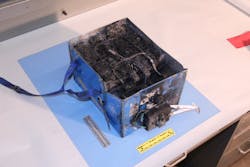NTSB releases preliminary findings in investigation of Boeing 787 battery fire in Boston
WASHINGTON, 25 Jan. 2013. "We have not ruled anything out as a potential factor in the battery fire; there are still many questions to be answered," explained National Transportation Safety Board Chairman Deborah A.P. Hersman as she released preliminary findings from the NTSB's ongoing investigation into the 7 Jan. 2013 Boeing 787 battery fire in Boston.
"One of these events alone is serious; two of them in close proximity, especially in an airplane model with only about 100,000 flight hours, underscores the importance of getting to the root cause of these incidents," Hersman said, referencing the Boeing 787 battery incident in Japan on 16 Jan. 2013, which is being investigated by the Japan Transport Safety Board.
The NTSB investigation revealed that the battery in the 787 fire in Boston showed signs of short circuiting, and had indications of thermal runaway, a situation in which a significant temperature increase can initiate a destructive chain reaction.
Hersman also expressed concerns about the adequacy of the systems to prevent such a fire from occurring: "The investigation will include an evaluation of how a fault that resulted in a battery fire could have defeated the safeguards in place to guard against that. As we learn more in this investigation, we will make recommendations for needed improvements to prevent a recurrence."
Investigators developed and released the following timeline of the events on 7 Jan. 2013:
10:06 am EST - Aircraft arrived at gate in Boston from Narita, Japan
10:32 am - Cleaning and maintenance crew noticed smoke in cabin
10:35 am - Mechanic noted flames coming from APU battery in aft electronics bay
10:37 am - Airport Rescue & Fire Fighting notified
10:40 am - Fire and rescue personnel arrive on scene
12:19 pm - Fire and rescue personnel report event was "controlled"
The batteries were manufactured by GS Yuasa for the Thales electrical installation and are unique to the Boeing 787. The same battery model is used for the main airplane battery and for the battery that is used to start the auxiliary power unit (APU), one of which caught fire in Boston.
Radiographic examinations of the incident battery and an exemplar battery were conducted at an independent test facility. The digital radiographs, or computed tomography (CT) scans, generated from these examinations allowed NTSB investigators to document the internal condition of the battery prior to disassembling it.
Ongoing lab work includes an examination of the battery elements with a scanning-electron microscope and energy-dispersive spectroscopy to analyze the elemental constituents of the electrodes to identify contaminants or defects.



